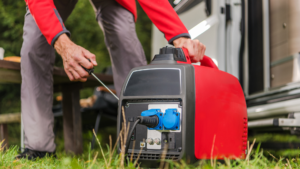 An inverter generator is a portable generator that adjusts its engine speed to match electrical demand, rather than running at a constant speed, the way a traditional generator does. Inverter technology produces cleaner power, while also reducing noise and fuel consumption. If you’ve seen one in the store and asked “What is an inverter generator?” it’s time you learned not only what they are, but how they work and why they’re so popular.
An inverter generator is a portable generator that adjusts its engine speed to match electrical demand, rather than running at a constant speed, the way a traditional generator does. Inverter technology produces cleaner power, while also reducing noise and fuel consumption. If you’ve seen one in the store and asked “What is an inverter generator?” it’s time you learned not only what they are, but how they work and why they’re so popular.
How an Inverter Generator Works
The way inverter generators produce electricity is more complicated than traditional generators. The first stage is the same. The engine burns fuel to turn a rotor that generates AC (Alternating Current) power. But instead of sending it directly to the control panel, inverter generators send it to a device called a rectifier. Rectifiers convert AC power into DC (Direct Current) power, which is then converted back into AC power by a computer inside the generator, before being sent out to your devices.
Advantages of Inverter Generators
Inverter generators are more expensive than traditional generators. But while their short-term costs are high, they’re generally outweighed by their long-term benefits, such as:
- Fuel Efficiency. Because the motor throttles back as electrical demand dips, inverter generators burn less fuel over time.
- Less Noise. While a traditional generator produces 80 decibels or more, an inverter generator only produces around 60 ‒ a quieter choice for camping and tailgating parties.
- Portable. Inverted generators have compact motors, making it easier to fit them into tight spaces. They’re also lighter than traditional generators, so they’re easier to carry as well.
- Clean Output. Inverted power has less than three percent harmonic distortion, which means the generator’s output is at or near 60 hertz (standard frequency for the USA), making it far less likely to burn out your electronics.
- Less Maintenance. Inverter generators have fewer moving parts than traditional ones. And because they run at slower speeds when you draw less power, they experience less wear and tear, which means less time, effort, and money has to be spent on their upkeep.
The one true downside of inverter generators is their strength. Even the largest can’t produce more than 5,000 watts, while a large, traditional generator can produce over 12,000. However, one of the advantages of inverter technology is parallel capability. Instead of relying on a single generator, you can connect two inverted generators to power larger devices, even your entire home.
Protecting Your Electrical System
Agway not only powers your home. We protect it. An inverted generator can keep your home running when your wiring fails, but getting your house back online is often more difficult and expensive. Repairs can cost hundreds, sometimes even thousands of dollars.
Our EnergyGuardTM Program covers your heating, cooling, and electrical systems* against damage caused by wear and tear. When the need for repair occurs, our customers don’t have to waste time hunting for a qualified electrician or repairman.
Our support team is standing by 24/7. Backed by an extensive network of local contractors, they send someone to your door as quickly as possible and pay for all corrective maintenance and covered parts. There are no service fees or deductibles. Everything is covered in your supply cost. So what are you waiting for? Sign up today to start saving on repairs!
*Coverage depends on commodity purchased.